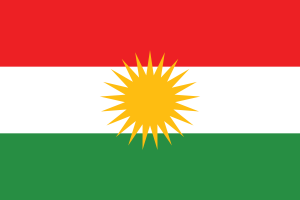Language/Central-kurdish/Grammar/Present-Tense
| ◀️ Months and Seasons — Previous Lesson | Next Lesson — Past Tense ▶️ |
Introduction[edit | edit source]
In the journey of learning Central Kurdish, understanding verb tenses is crucial for effective communication. Verbs play a vital role in expressing actions and events happening in the present moment. In this lesson, we will focus on the present tense in Central Kurdish, which will enable you to describe ongoing actions and current states. By the end of this lesson, you will be able to confidently use the present tense in various contexts.
Formation of the Present Tense[edit | edit source]
The present tense in Central Kurdish is formed by adding specific suffixes to the verb stem. These suffixes vary depending on the subject pronoun associated with the verb. Let's explore the different suffixes for each subject pronoun:
Personal Pronouns[edit | edit source]
| Subject Pronoun | Suffix |
|---|---|
| Ez (I) | -im |
| Tu (You, singular) | -î |
| Ew (He/She/It) | -e |
| Em (We) | -in |
| Hûn (You, plural) | -în |
| Hûn (They) | -in |
Examples[edit | edit source]
- Ez dibêjim. (I speak.)
- Tu dibêjî. (You speak.)
- Ew dibêje. (He/She/It speaks.)
- Em dibêjin. (We speak.)
- Hûn dibêjin. (You speak.)
- Hûn dibêjin. (They speak.)
Usage of the Present Tense[edit | edit source]
The present tense in Central Kurdish is used to describe actions or events that are happening at the present moment. It can also be used to express habitual actions or general truths. Here are some common scenarios where the present tense is used:
1. Describing Current Actions[edit | edit source]
When you want to describe an ongoing action that is happening right now, you can use the present tense. Let's look at some examples:
- Ez dixwim. (I am eating.)
- Tu dixwî. (You are eating.)
- Ew dixwê. (He/She/It is eating.)
- Em dixwin. (We are eating.)
- Hûn dixwin. (You are eating.)
- Hûn dixwin. (They are eating.)
2. Expressing Habits[edit | edit source]
The present tense can also be used to express habitual actions or routines. For example:
- Ez her roj dixwim. (I eat every day.)
- Tu her roj dixwî. (You eat every day.)
- Ew her roj dixwê. (He/She/It eats every day.)
- Em her roj dixwin. (We eat every day.)
- Hûn her roj dixwin. (You eat every day.)
- Hûn her roj dixwin. (They eat every day.)
3. Stating General Truths[edit | edit source]
The present tense can also be used to express general truths or facts. Consider the following examples:
- Çavkanîyek pir baş e. (Reading is very good.)
- Çavkanî pir zehmet e. (Studying is very difficult.)
- Hêvîkarîya me di her tiştî de heye. (Hope is present in everything.)
Cultural Insights[edit | edit source]
In Central Kurdish-speaking regions, the present tense is widely used in everyday conversations. It allows speakers to effectively communicate ongoing actions, habits, and general truths. It is important to note that Kurdish culture places great emphasis on hospitality and community values. Therefore, using the present tense to express actions and events happening in the present moment helps create a sense of connection and immediacy in conversations.
Interesting Fact: The Kurdish language has a rich literary tradition, with works dating back centuries. Many renowned poets and writers have used the present tense to vividly depict scenes and emotions, capturing the essence of Kurdish culture and identity.
Practice Exercises[edit | edit source]
Now it's time to practice using the present tense in Central Kurdish. Complete the following exercises and check your answers below:
Exercise 1: Translate the following sentences into Central Kurdish using the present tense:
1. I am reading a book. 2. She is singing a song. 3. We are watching a movie. 4. They are playing football. 5. You (plural) are cooking dinner.
Exercise 2: Translate the following sentences from Central Kurdish to English:
1. Ez dixwim. 2. Ew dixwê. 3. Tu dixwî. 4. Hûn dixwin. 5. Em dixwin.
Exercise 1: Solution
1. Ez xwendinê dikim. 2. Ew şarkê dibêje. 3. Em filmê dibînin. 4. Hûn futbolê dimirin. 5. Hûn şevê nexwazin.
Exercise 2: Solution
1. I am reading. 2. He/She/It is reading. 3. You are reading. 4. They are reading. 5. We are reading.
Conclusion[edit | edit source]
Congratulations! You have successfully learned how to form and use the present tense in Central Kurdish. The present tense allows you to express actions and events happening in the present moment, as well as habits and general truths. Keep practicing and incorporating the present tense into your conversations to enhance your language skills. In the next lesson, we will explore the past tense in Central Kurdish.
Other Lessons[edit | edit source]
- Subject Pronouns
- How to Use Be
- Negation
- Conditional Mood
- Adjectives
- Forming Simple Sentences
- Pronouns
- Future Tense
- Possessive Pronouns
- Common Prepositions
Template:Central-kurdish-Page-Bottom
| ◀️ Months and Seasons — Previous Lesson | Next Lesson — Past Tense ▶️ |

